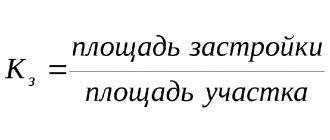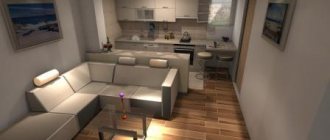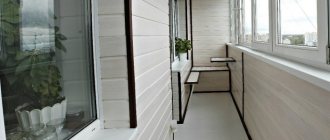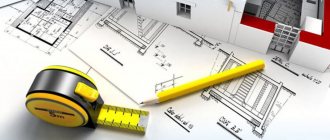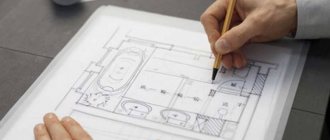Why is it important to know what area is considered living space in an apartment?
A detailed calculation of the residential, usable or total area of a residential premises may be needed in several cases:
- For litigation. For example, if the common property of the spouses is divided, the inheritance is disputed, the agreement on shared participation in construction is changed or terminated.
- To determine the cost of housing, taking into account the average price per square meter in the primary or secondary markets.
- To determine the tax base when calculating the property tax of an individual.
- To obtain housing under a social rental agreement.
- To calculate compensation for rental housing for military personnel.
- To process compensation and benefits.
Note: in the above situations, when determining living space, you need to focus on the norms of the Housing Code of the Russian Federation. In all other cases - according to the Federal Law dated December 30, 2009 No. 384-FZ “Technical Regulations...”, SP 54.13330.2016.
Take the survey and a lawyer will tell you for free how to avoid mistakes in an apartment purchase and sale transaction in your case
Difference between common and living area
Few residents think about which square meters are in the nature of a residential apartment, and which are an apartment as such. Balconies, bathroom, kitchen, stairs - what do they belong to? These little things can significantly affect not only the accrual base for paying for utilities, but also the market value of housing.
To calculate the value of an apartment, the size of the area specified in the share agreement is taken. Based on this rule, buyers should carefully study this agreement and not rely on advertising from the developer and his proposed square meters. The size of the area specified in the contract may differ from that advertised by the developer. It all depends on the motivation of the seller. The cost of an apartment depends on the area. What the developer includes in this area should be clarified, since the price plays a role in this.
We recommend reading: How to Check Documents for a House Before Buying
What does the living area of an apartment mean?
According to the law, a residential area is considered to be an area that includes all premises suitable for permanent residence:
- Bedroom.
- Cabinet.
- Hall.
- Children's room.
In fact, living space refers to rooms in which you can put a sofa or bed and relax. The kitchen, corridor, bathroom, etc. are not suitable for these purposes.
Agreement for the sale and purchase of an apartment with furniture and household appliances
The act of acceptance and transfer of the apartment under the purchase and sale agreement
Total area and living area of the house
The total living area is calculated as follows: the areas of rooms and utility rooms are added up.
Utility rooms are considered to be bathrooms, toilets, storage rooms, built-in closets, corridors, as well as stairs located in the house. The concept of living space is practically not used in law and in practice and is more theoretical than applied. The total living area is needed only to assess (for example, when buying a home) whether you have enough living space. For example, in a private house there may be a huge vestibule, which is taken into account when calculating the total area, although in each specific case, in order to make a decision on purchasing a home, one must be guided not only by documents, but also by inspecting the future home.
What applies to the total area of an apartment according to the Housing Code?
In Art. 15 of the Housing Code of the Russian Federation states that the total area includes all residential and auxiliary premises. The exception is balconies, loggias, verandas and terraces: they are not included in the total area.
For example, if a one-room apartment with an area of 40 sq.m. is purchased under the DDU, of which 3 sq.m. is a balcony, by law it is taken into account with a reduction factor of 0.3, and in reality the total area is 37.9 sq.m.
What is included in the usable area of the apartment?
By useful we mean the area of several rooms:
- Residential: rooms, bedrooms, living room, office.
- Auxiliary: bathroom, kitchen, balcony, etc.
Calculation with a reduction factor
The reduction factor is used to calculate the total area when purchasing housing under a shared construction agreement. It only applies to:
- Loggias – 0.5.
- Balconies – 0.3.
- Veranda – 1.0.
- Terraces – 0.3.
For example, if the area of residential and auxiliary premises is 50 sq.m., and the loggias are 5 sq.m., the total area of the apartment will be:
5 x 0.5 = 2.5 – taking into account the coefficient.
50 + 2.5 = 52.5 sq.m. – total area according to preschool building.
Are you tired of reading? We’ll tell you over the phone and answer your questions.
What is the footage of an apartment made up of: calculation rules and examples
When purchasing residential real estate, it is important to know by what principle the square footage is calculated. Our material talks about what the total, living area and apartment area are, and how they differ. We will answer frequently asked questions and provide examples with calculations.
Residential
Living area (S) - the total footage of all living rooms (living rooms, children's rooms, offices, bedrooms - premises suitable for permanent residence, they must have a window).
Please note: the living space can be increased through corridors and storage rooms if redevelopment is carried out. The redevelopment is registered in the technical passport. If you do it “illegally”, the additional footage will be invalid.
To calculate the quadrature, a plan is needed. It indicates the footage of each individual room.
Example: Three-room apartment. Three rooms - area - 13, 24 and 20 m². respectively. Corridor – 6 m², kitchen-dining room – 13 m², bathroom – 7 m². As a result, we get S: 13 m² + 24 m² + 20 m² = 57 m².
General
The total footage includes all residential and auxiliary premises:
- Rooms. These are children's rooms, living rooms, bedrooms, offices.
- Corridors that connect parts of the living space with each other.
- Kitchens and dining rooms.
- Niches in the walls (“winter refrigerators” in Stalinist houses). Niches whose height is more than 1.8 m are taken into account.
- Toilets, bathrooms (bathrooms).
At the same time, common house areas are not taken into account: these include loggias, balconies, as well as verandas and terraces (if any). When calculating, fireplace stoves, areas under the stairs (provided that their height is less than 1.6 m), arches and doorways less than 2 m wide are excluded. Knowing what the total footage is and how to determine it, you will not overpay for extra "squares" when purchasing real estate.
The plan indicates the footage of each room. All that remains is to add up the living and auxiliary premises. If there is no plan, you can take measurements yourself:
- Draw a diagram of the living space on a sheet of paper.
- Measure the length of all walls of the apartment at the level of the baseboard (inner side), record the obtained values on the diagram. If there are non-standard rooms, for example, with niches, divide them into separate “shapes” and enter the values into the plan.
- Determine the quadrature of each room (the product of length and width), add up the results.
Example: Three-room apartment. Three rooms - footage - 13, 24 and 20 m respectively. Corridor – 6 m², kitchen-dining room – 13 m², bathroom – 7 m², balcony – 6 m², niche in the wall 1.5 m high. As a result, we get: 13 m² + 24 m² + 20 m² + 6 m² + 13 m² + 7 m²= 83 m².
Apartment area
It is the sum of the areas of the apartment, calculated with a special coefficient. The law sets a certain value for each of the rooms (for residential - 1.0).
A reduction factor is also used. This is a legal reduction in the cost of living space. It amounts to:
- For balconies – 0.3.
- For loggias – 0.5.
- For terraces – 0.3.
- For verandas – 1.0.
Example. The area of auxiliary and residential premises is 120 m². The apartment has two loggias with an area of 10 m². In this case, the calculation is carried out as follows:
- Loggia area * reduction factor: 10 m² * 0.5 = 5 m².
- The total area according to the DDU will be: footage of auxiliary and residential premises + loggias, taking into account the coefficient: 120 m² + 5 m² = 125 m².
For apartments with a balcony, the footage is calculated similarly. The reduction factor is 0.3, so the “squares” placed outside the facade must be multiplied by 0.3 and then added to the total footage of the apartment.
Important: a plan is included in the purchase and sale agreement. Pay attention to the “summer unheated sections” - loggias and balconies, check whether a reduction factor is applied to them.
If the summer section is insulated, it is recognized as residential. It is necessary to make appropriate changes to the redevelopment to avoid problems with the BTI. In this case, the footage of the balcony is taken into account when calculating the total area without a reduction factor.
How to determine the total area of an apartment?
You can calculate the total and living area by reading the layout. The footage of each room will be indicated there. All you have to do is write down the numbers and add them up.
Example:
Three bedroom apartment. The area of one room is 10, the second is 12, the third is 13 sq.m. Kitchen – 10 sq.m., bathroom – 6 sq.m., corridor – 8 sq.m.
The total is:
10 + 12 + 13 + 10 + 6 + 8 = 59 sq.m.
If there is no plan
You can calculate the living or total area yourself if you don’t have a plan on paper. To do this, just take a tape measure, a notebook or notepad, and a pen. If there are non-standard angles, you will need a protractor.
If the room is square or rectangular, you need to measure the length of two walls from one corner and multiply them. When unequal numbers are obtained, the two digits after the decimal point are rounded.
Legal advice: if the room is round or triangular, it is better to invite a specialist to do the calculations. Their area is calculated using separate formulas, and the calculation requires the most accurate measurements.
Elena Plokhuta
Lawyer, website author (Civil law, 7 years of experience)
The difference between the total area of an apartment and the living area
An ordinary Russian citizen is most often not aware of how many square meters of his apartment are considered residential, and which ones belong to the total area of the apartment. For example, questions immediately arise regarding the bathroom and kitchen. Where should I take them? What if there is a balcony or loggia, and in two-level apartments there is also a staircase? How to calculate the living space in an apartment?
The above abundance of legislative terms can confuse anyone, which leads to the emergence of controversial situations in practice. Most often, such situations arise when concluding an agreement for participation in shared construction of an apartment building, in which the description of the property is based on data from the design documentation for the entire building. Building codes and regulations that apply to the design and construction of multi-apartment residential buildings require that areas be calculated in accordance with the above-mentioned Instructions. The same document is used when registering an apartment for cadastral registration. From this it follows that in these cases the calculation of the total area takes place taking into account reduction factors.
Lawyer's answers to private questions
How to determine the living area of an apartment?
It is enough to sum up the area of all residential premises: bedrooms, rooms, hall. Auxiliary premises are not included here.
My husband and I are planning to divorce. We jointly own an apartment of 70 sq.m. with loggia 5 sq.m. Will it be taken into account in the total quadrature during the division, or not?
No, the area of the loggia is not taken into account when dividing.
I will be selling my apartment soon. How should I indicate the total area in the ad: with or without a balcony?
The general room is indicated without a balcony.
Our house was declared unsafe. They plan to allocate new apartments, the old one is 55 sq.m. How will their area be calculated?
Must be given another apartment of at least 55 sq.m. If the area is larger, you will have to pay extra, but without taking into account the square footage of the balcony or loggia.
I added a room to a private house. Naturally, the total area has increased. What are my next steps?
You need to issue a new technical passport from a cadastral engineer, and then make changes to the Unified State Register.
Does the total area include:
What is included in the common space of the apartment:
- Rooms.
- Bathroom and toilet.
- Kitchen.
- Storage room and so on.
In fact, the total area includes almost everything, with the exception of the loggia, balcony, basement, porch, attic, attic, and so on. The easiest way to determine whether an object belongs to the total area of the apartment is to check its heating. If, for example, the loggia is heated, then it is included in the common space of the apartment. If not, then no.
How to calculate living space?
To solve such a complex puzzle, you need to understand what the living area of an apartment includes.
An apartment or house may include:
- rooms,
- kitchen,
- corridor,
- hallway,
- bath and toilet or combined bathroom,
- pantry,
- built-in wardrobe.
The expression “living rooms” is also familiar to many, and this phrase contains the key to the solution. We live in the entire apartment, but mainly in rooms .
When it is important to know the difference between the living area and the total area of the apartment
- When choosing real estate, it is important to remember that balconies or loggias are not included in the total area of the property . When purchasing an apartment, it is worth checking whether the owner (the development company) included them in the overall square footage of the apartment. This is important, since the total area of all premises affects the market value. Sometimes the footage of a balcony or loggia can be taken into account, but then this must be done with a reduced coefficient.
- The living area is always less than the total area , with the exception of the case discussed above, therefore, even if two apartments have the same total square footage, one apartment may seem smaller than the other due to the smaller area of the living rooms.
- It is important to know that fees for housing maintenance and major repairs, as well as utility bills (in the absence of an individual meter), directly depend on the total living space . Property tax and rental fees are also calculated.
- The size of the living space is the main indicator for determining the degree of need of a family to improve living conditions. Also, this indicator will play a decisive role when allocating housing to a family under a social lease agreement or allocating funds for its purchase under government social programs, for example, for young families, orphans and military personnel.
- In an apartment building, the common property is divided between the apartment owners, also based on the total square footage of the occupied apartments. And this share, in turn, is decisive in the distribution of the number of votes at the general meeting of owners in apartment buildings. That is, the more squares there are in the property, the greater the role the owner plays in resolving general house issues.
This is important to know: Preferential mortgage for secondary housing in 2021
There are many situations in life when knowing which concept is used and when can be useful. Awareness of this issue will help in real estate transactions or in monitoring the correct calculation of utility bills and determining social norms, which can greatly make life easier and save the family budget.
What does the law say?
Usually, to decipher a particular significant concept, it is most reliable and easiest to resort to the help of current legislation: how it is interpreted there is how it should be understood .
But the whole point is that it is not defined in any way in the laws, moreover, it is not even mentioned practically anywhere. There is room, but no space .
The only exception is the law regulating the social protection of the rights of people with disabilities in Russia. But there, these words mean the premises as a whole, that is, an apartment, a private house or a room - everything classified by law in this category.
Watch the video: Technical passport of residential premises, types and functions
But as the practice of using this term shows, we are usually not talking about the property as a whole, but about a certain part of it. So the question arises: what is included in the living area of the apartment and what to do with the remaining parts - are they really non-residential? But from the point of view of current legislation, the entire premises as a whole are residential. So go figure out what actually belongs to the living space, what is customary to include in it.
There is usually no data on living space in official documents for an apartment . Let's imagine the situation. You put your home up for sale, buyers started calling, asking what the living space is, and what should you tell them? And where does this information come from in other similar advertisements or descriptions of apartments on developer websites? In general, go there, I don’t know where, bring something, I don’t know what.
What is the total area of the apartment and what does it include?
- Living rooms. Bedrooms, living rooms, children's rooms - everything in which people spend most of their time, in which they sleep, work, spend time at the computer or a good book.
- Kitchens. Regardless of how much time the apartment owner spends in the kitchen, it is still considered a household space and is taken into account in the total area. Even if the owner has made a cozy nest in it for watching movies and reading books, and leaves it only to go to work and satisfy natural needs.
- Corridors. Any corridors connecting the rooms of the apartment from the inside.
- Sanitary rooms. Bathrooms, toilets, combined bathrooms, they are all part of the total area, but not part of the living area. No matter how tempting it may be to spend all your time in them.
- Wall cabinets. Despite the fact that a person does not enter them at all, they are taken into account in the area of the apartment, if they are not too small for this.
- "Khrushchev's refrigerators." Niches in the walls, made back in Stalin's times so that that part of the population that could not afford a refrigerator could store food in them, also count towards the total area.
- If the room is rectangular, just arm yourself with a tape measure and measure the length of its two walls connecting at an angle. And then remember your school lessons on calculating area and multiply one value by another, getting the area of the room. This option is the simplest, but rarely encountered.
- If the room has a complex shape, it is enough to divide it into imaginary rectangles that will be easy to measure, and measure them one by one. First, two sides, then multiply the value of their lengths, then do the same with other rectangles and, in a long expression, add all the values into one, getting the total area of the room.
- diagonal walls it is enough to imagine an imaginary rectangle, the diagonal wall for which will be the hypotenuse, and measure its sides. Multiply the values of their lengths and divide the resulting result by two. Add the areas of the other rectangles shown.
